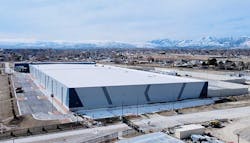Aligned Continues its Expansion With Second Salt Lake City Data Center
Aligned continues to expand its footprint across the United States. The company has completed a second data center at its campus in West Jordan, Utah, part of the growing cloud cluster in Salt Lake City market. The 240,000 square foot facility offers 48 megawatts of capacity, and can be expanded to 60 MW.
“Aligned’s second Salt Lake facility, our latest greenfield deployment, underscores our commitment to delivering adaptive and sustainable data center infrastructure to meet customer demand in the Silicon Slopes and beyond,” says Andrew Schaap, CEO of Aligned. “The growth of this vibrant Western technology hub, combined with some of the most attractive tax incentives in the U.S., has prompted many companies to deploy infrastructure in the Salt Lake City region.”
Aligned specializes in solving capacity management challenges through innovation in cooling and the supply chain. Its offering is positioned to appeal to technology-focused customers, especially growing Internet companies. In addition to its Salt Lake City campus, Aligned operates data center campuses in Dallas, Phoenix and Ashburn, Virginia.
Salt Lake City now has several major data center campuses, including single-tenant sites for Facebook, eBay and the National Security Agency, as well as a multi-tenant facilities for DataBank and Flexential. Newcomer Novva Data Centers recently announced plans to build a wholesale data center campus in West Jordan.
The Salt Lake City region sits on long-haul fiber routes, with power available at 5.8 cents per kilowatt hour and a climate that supports using fresh air for cooling for about 75 to 80 percent of the year, which reduces cooling costs. Salt Lake City’s cost profile has been boosted by economic incentives passed this year that opened sales tax abatements on data center equipment to tenants of colocation space.
Large, expandable buildings provide customers with the flexibility to add new capacity in large chunks. In a period of rapid growth for Internet services, hyperscale operators are seeking runway to accommodate accelerated growth that can be unpredictable. This need was reinforced during the early weeks of the COVID-19 pandemic, as demand for cloud services surged rapidly as users shifted activity online during government-imposed lockdowns.
Each Aligned data hall includes a cooling wall featuring vertical stacks of its Delta Cube cooling units, which are about 4 feet wide and house multiple fan coils, allowing them to cool workloads of up to 50 kW per cabinet. The wall also contains space that allows for additional rows of Delta Cube units to be installed, providing additional capacity within the data hall. (For a deeper dive, see Case Study: Aligned Ashburn Data Center Campus)
About the Author



